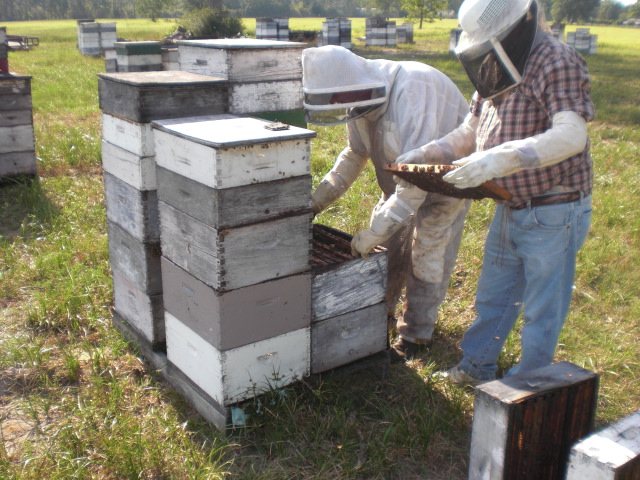
Summer is often the time when most panhandle beekeepers have harvested their prime honey crops (TiTi, Tupelo, Gallberry and in some years Palmetto). If the beekeeper plans to reap a good honey harvest next year, hive maintenance must be top priority during the summer months.
As I talk with beekeepers here in Gulf County and throughout the panhandle their main concern is controlling Varroa Mites and Small Hive Beetle. According to Apiculturist Dr. Jamie D. Ellis with IFAS of the University of Florida, the best strategy for controlling the Varroa mite is by using Integrated Pest Management. For example, use resistant queen stock (hygienic, Russian, or New World Carniolan Queens) and screened bottom boards to reduce Varroa populations. When Varroa populations are high, consider using Varroa treatments such as Apiguard or formic acid.
Since the introduction of small hive beetles into the U.S., little progress toward developing chemical control methods has been made (Hood 2004). The two available chemical controls for small hive beetles are Guard StarTM a ground drench used around colonies to kill pupating beetles, and Check MiteTM a plastic strip used under pieces of cardboard in colonies to kill adult beetles. As is the case for all insecticides, it is important to follow the product label when using these products to control small hive beetles. Preferential to chemical treatment, beetle adults can be trapped in colonies using traps such as the Beetle Blaster, the Hood trap, etc.
During the summer months there are very limited amounts of blooming (nectar) producing plants. Palmetto and Chinese Tallow offer some relief. Some beekeepers have starting utilizing cotton fields as a source of nectar and pollen, since virtually all cotton grown in the south are BT cotton varieties. Much fewer insecticides applications are applied as in the past when bollworms were so prevalent. Beekeepers would still need to work very closely with a cotton grower to protect their hives from pyrethroid and organophosphate insecticides used to control stink bugs in cotton.
Remember an ounce of prevention is better that a pound of cure. Summer is a good time to treat hives with Terramycin or Tylan for American Foulbrood Prevention. Summer is a good time to make nucs/splits (increases). If there is any doubt about the queen’s condition, serious thought should be given to requeening. Some beekeepers requeen in late summer or early fall on a regular annual basis. New queens lay at a higher rate than older ones. Late summer requeening allows for multiple opportunities to achieve queen acceptance. The resultant population is larger. Additionally, a first-year queen is much less apt to swarm the following spring.
A very useful tool that every beekeeper should have at their disposal is the “Beekeeper Management Calendar.” It is specific to region (North, Central, South Florida), quarter (spring, summer, fall, winter), and month. The calendar includes recommendations for major management considerations such as when to treat for parasites or pathogens, and the local flora in bloom at that time. For more information consult your local Cooperative Extension Office, or contact your local Bee Inspector.
 0
0
